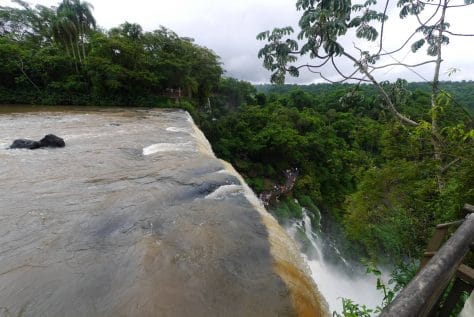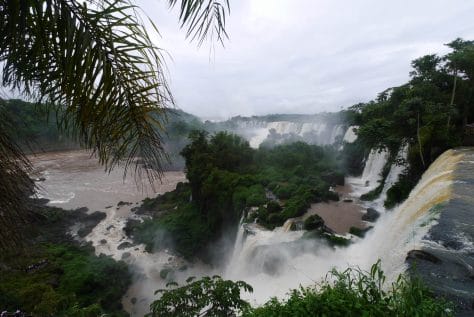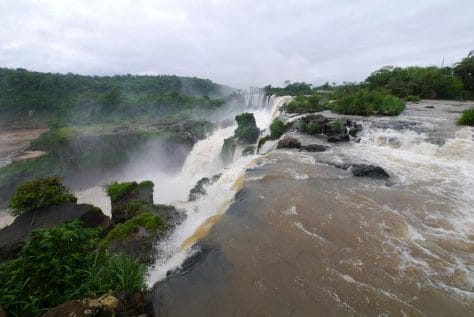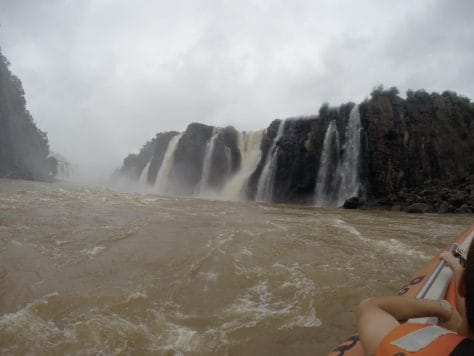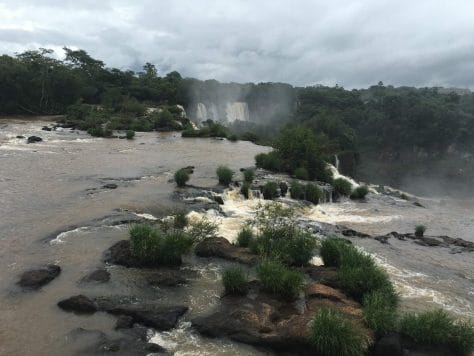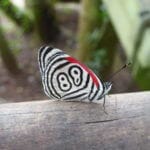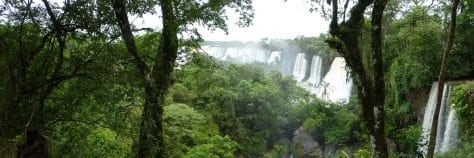Iguaçu Falls; even the name sounds exotic (it means ‘big water’ in the local Guarani language). While a great many more people nowadays have actually heard of them, the relative expense of actually getting there puts off a lot of people.
I have been fortunate enough to be able to visit them twice, most recently in January 2016. Hopefully my photos here will be enough to convince you that you really should add them to your travel itinerary.
Situated in the heart of the jungle, the Falls themselves form the natural border between Argentina and Brazil. An umbrella park that crosses the geographical border to create a conservation zone and protect over 60,000 hectares (167 acres) of prime rainforest. Unlike Niagra’s 2 falls, Iguaçu is made up of up to 275 separate falls that form along a 2 mile stretch of the Iguazu River. The number of Falls fluctuates with the level of the river but they rarely cease to be anything apart from spectacular.
Getting There
Getting there is now more convenient thanks to a daily flight on the Brazilian side to Foz Do Iguaçu and 3 daily flights to Puerto De Iguaçu from Buenos Aires on the Argentinian side.
Argentina has the larger slice of explorable falls but the Brazil side shouldn’t be ignored because the panoramic views are stunning. Unfortunately the visa situation may put you off if you need to get one for the roughly 2 hour visit it takes to really do the Brazilian side justice. Check with your embassy about visa requirements before you travel.
Flying in from Buenos Aires on both my visits I haven’t stayed in Foz Do Iguaçu yet because flying from Argentina to the Brazilian side is cost prohibitive and very time consuming (and vice versa) while 3 hours after taking off from the sprawling metropolis that is Buenos Aires the plane doors fling open to an altogether easier pace of life. And humidity.
Staying There
From my research before my last visit, Foz Do Iguaçu is cheaper than it’s Argentine cousin over the river. Puerto Iguazú is becoming surprisingly expensive to eat out in. Between my visits (June 2012 to January 2016), I noticed a marked increase in the expense of eating out. Souvenirs are still great value but finding a hotel to stay in and a decent restaurant may stretch your purse strings more than you hoped. You can cut the cost of accommodation by staying in one of the many B&Bs that are popping up all over town.
Puerto Iguazú has a frontier town feel to it which is apt seeing as you can find the Tres Fronteras here; the much photographed border between 3 countries; Argentina, Brazil to the north and Paraguay to the west.
Getting Around
If you don’t hire a car be prepared to get a taxi everywhere (20 minutes transfer from the airport to town). It’s a surprisingly large city compared to many people’s expectations of it, mine included before my first visit. Most of the big hotels are located outside of the main town nearer to the Falls.
Getting around is easy thanks to the abundant taxis and tour offerings. If you don’t want to drive, you don’t have to. You just need to be organised and know how you are going to get about.
Parque Nacional De Iguaçu (Argentina)
Getting to the Parque Nacional de Iguaçu (the Argentinian side) is plenty easy to do on your own with a taxi. The Falls are around 15 minutes from most of the hotels. Alternatively you can arrange a park tour with a local operator who will pick you up from the hotel by bus and take you on a guided tour.
Whilst I found the background information useful, I thought the pace was a little rushed. I wanted more time to be able to explore off the main paths and this year I managed that with ease by taking a taxi and spending all day in the park instead of the 5 or 6 hours that most tours spend there.

These cute looking guys are everywhere within the park. Don’t feed or touch them. They love fingers!
You will find the mornings the busiest as most of the tours arrive between 9am-10am but leave mid afternoon giving you more time to take in your surroundings in relative peace for the last 2 hours compared to the hoards of people that you will face first thing. With the afternoon though comes the risk of rain (this is the rainforest after all). Showers can be heavy, very heavy but don’t usually last longer than 20 minutes to half an hour in the dry season (April to June).
Garganta Del Diablo – the Devil’s Throat

The Devils Throat in full flood under an angry sky after heavy rains caused by El Niño- January 2016

Walking out to the falls you will join hundreds of others as you walk a few feet above the river. Be sure to keep an eye out for the abundant wildlife on the way.
Aside from the upper and lower circuits ‘Circuito Superior’ and ‘Circuito Inferior’, the main attraction is Garganta Del Diablo, The ‘Devil’s Throat’, where roughly 50% of the water is concentrated. Getting there though is not quite as easy as you may think. It will either involve a 15 minute train ride (with up to an hour or more queue) or a 50+ minute walk, sometimes in knee high mud depending on the rains. Once at the Estacion De Garganta Del Diablo the falls are actually 1km away accessed by a walkway over the river which at this point is over 1,500 meters wide.

Walking out to the Devil’s Throat the river at first appears to be abnormally calm but the spray of the thundering falls is visible from quite a way away.
The park is surprisingly large but aside from a couple of restaurants not far from the entrance there is very little infrastructure so if you want to stay all day make sure to bring your own water and food. A waterproof layer could come in handy too.
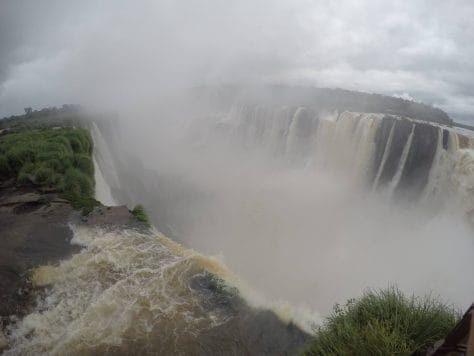
Staring downstream from the very edge of the falls, the sound is deafening and more often than not it’s a very wet experience. This is the boundary between Brazil and Argentina.
Circuito Superior
Walking the two main routes takes you along almost the entire length of the falls. The park has faced the full onslaught of mother nature in recent years and you will see scars of this as you walk around and notice old footers in the river or walkways that lead to nowhere.
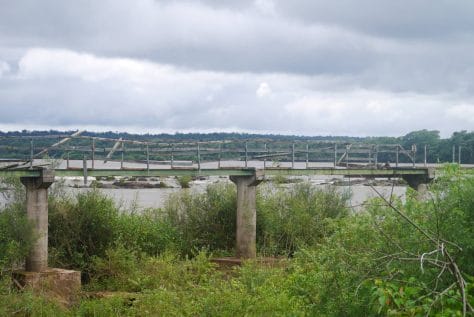
Walking out the the Devil’s Throat you will come across remnants of previous walkways that were washed away in a big flood a few years ago.
Circuito Superior (sometimes referred to as Paseo Superior on notices, meaning Upper Trail) is the upper walkway that’s takes you further along the falls, 1,750 meters in total. Finishing up with a panoramic view over the second largest falls of the entire system, the San Martin Waterfall. You will find yourself constantly stopping to take photos.
Every bend reveals another brilliant photograph opportunity of fairy tale waterfalls cascading over cliffs where trees cling to the very edges and vines swing in the breeze between branches. You should allocate at least a couple of hours for this. Even if you are a fast walker, photo taking and that of other people around you will slow you down quite considerably.
Being on the same side as most of the falls you would think that there wouldn’t be the chance of the same panoramic views you have from the Brazilian side but you would be wrong. Circuito Superior offers some truly breath taking views along the cascading waterfalls. Your main problem will be when to put the camera down and start enjoying the moment.
Walking between falls you will sometimes need to duck under branches. Crossing over precipitous drop offs, you will see thousands of gallons of water falling away beneath your feet. The walkways are that close to the edge.
Circuito Inferior
Where Circuito Superior (Upper Circuit) is about getting an overview, the Circuito Inferior is about getting up close and personal to the falls. Perhaps too close for some.
Access to the Upper circuit is easy because there are no stairs but the lower circuit will involve some stairs and won’t be suitable for those with mobility problems after a certain point. Bear in mind that the pathways round here will be slippery at times also. Watch your footing, particularly around the bases of the waterfalls.
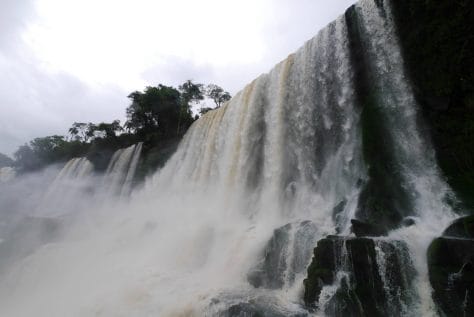
Looking up at the same Bozzeti Waterfall is far more intimidating from the Lower Circuit than looking down on the Upper Circuit
At 1,700 meters the Lower Circuit is a shade shorter than the upper circuit but that doesn’t mean that the photo opportunities are any less. You’ll need around 90 minutes minimum for this part of the circuit.
Zodiac Boat
It’s also from here, around 2/3 of the way in that there is an opportunity to take the much talked about zodiac boat tour along the river and very close to a couple of the waterfalls. The cost isn’t included in your entry but it is worth the extra dent in your wallet.

Approaching the boat dock after a 10 minute, sometimes slippery, stroll down from the Lower Circuit.
From your seat bobbing up and down you can really appreciate the power of the water flow as you motor your way over 6ft swells, at first towards the Garganta Del Diablo but the power of these falls is far too great for the RIB boats to get near to. You instead take a hard right into one of the small falls coming off San Martin Island before your skipper shuts off the engine and you drift back towards your start point. He fires up the engines once again, this time full throttle to get close to _________, the third most powerful in the system. If you aren’t already soaked through (highly unlikely) you will be in about 20 seconds. You can use your own waterproof camera to film the experience but they also record your experience on the boat which you can purchase when you arrive, dripping wet, back on dry land.
There are two types of tour, the ‘Big Adventure’, (Gran Aventura) or ‘Nautical Adventure’. In my opinion the Gran Aventura is not worth the extra cost. Stick with the Nautical Adventure where you’ll get dropped off where you started not back at the start of the park. The Big Adventure includes an open top “safari” through the park. In reality on the day of my visit it was just a muddy track with a minimal or non existent sighting of animals although you could hear them, just as you can from the normal trails.
Because of the steep and very slippery path to the dock from the lower circuit it isn’t wheelchair accessible and you have to be 12 years or older to ride. Sorry kids. For a round trip you’ll probably need the better part of an hour on a quiet day (30-40 minutes if you really push it), 90 minutes on busy days.
Time Management is key
Adding up both the upper and lower circuits and allowing at least an hour round trip out to Garganta Del Diablo, you begin to see the problem with the tours that offer to get you round in 5 hours. It is possible but you have to go at a pace you may not necessarily be comfortable with (especially in the oppressively humid months, remember once again, this is the rainforest). Factor in the zodiac boat ride as well and you are already out of time; something will have to give and that will be your independence from the group. There are many exhibits dotted around that you won’t have time to appreciate, lunch will be non existent or a packet of something while you work your way round the circuits.
While the tours serve their purpose (particularly for the Brazil side where the timing is almost spot on) if you are staying in Argentina there really isn’t that much of a need. You need to weigh up convenience against independence for yourselves.
Regardless of how you decide to visit you should make a visit to Cataratas Do Iguaçu one of your priorities.
The park hasn’t been built up like some kind of faux Disneyland to nature. The basic amenities are there; restrooms, a couple of restaurants, some informative exhibits and a maze of pathways to take you off the main tourist trail if you’re brave enough, such as the much less trodden Macuco Trail. The zodiac boat experience add a pleasant and not too unaffordable option to the mix, and if the river plays ball you can even get over to San Martin Island.
If you run out of time you will have the option of a second consecutive day here for 50% off which is advertised all over the park should you want to spend one more day in this garden of wonder and delight.
When you think you’ve had your fill of waterfalls, you realise that there is still the Brazilian side to explore. While not on the same scale as the Argentinian side, the experience you can have there in an afternoon is just as amazing. Join me next week to find out why.
 Copyright secured by Digiprove © 2016
Copyright secured by Digiprove © 2016

